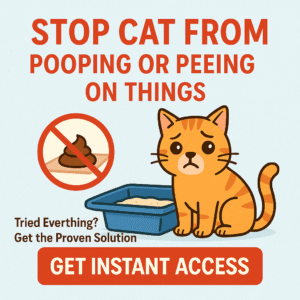When your cat begins peeing inside the house, it’s more than aggravating—it’s a sign something needs change. It can be a medical issue, anxiety signal, or simply confusion with the litter box. You deserve clear, humane solutions that work. This in-depth guide explains why this happens and offers practical steps you can take today to restore peace and cleanliness.
And yes—the Cat Spray No More ebook offers actionable routines and mindset tools that tie into every part of this process, helping you manage and prevent indoor accidents with confidence.
What Does Peeing Inside Really Mean?
Quick answer: Cat urinary accidents often point to medical issues, discomfort with the litter box, stress, or territorial behavior. Addressing the root reasons—rather than cleaning the mess—is the fastest route to lasting results.
1. First Step: Rule Out Medical Issues
Unless you’re 100% sure your cat is healthy, begin with a vet visit. Conditions such as:
- UTIs or bladder inflammation
- Urinary crystals or stones
- Kidney disease or diabetes
- Arthritis or mobility challenges
can make litter-box use painful or stressful. A diagnosis with blood tests and urinalysis lets you treat the problem quickly—often stopping accidents altogether.
2. Litter Box Set‑Up Matters More Than You Think
Even healthy cats can pee indoors if their litter box isn’t appealing. Focus on these key elements:
👍 Number of Boxes
- At least one per cat, plus one extra.
👍 Cleanliness
- Scoop at least once daily, preferably after each use.
- Replace litter and wash box weekly with unscented soap.
👍 Box Design & Litter Choice
- Choose open-top over covered boxes to avoid trapping odors.
- Use a large box—your cat should be able to turn around comfortably.
- Opt for unscented, fine-clumping litter that’s gentle on paws.
👍 Box Placement
- Position in quiet, low-traffic areas—avoid near noisy appliances.
- Provide easy access: don’t block access with furniture.
- Ensure multiple levels if your home has floors—don’t make cats trek far.
3. Stress, Anxiety & Environmental Triggers
Cats can pee indoors in response to stress. Common triggers include:
- Changes at home—moves, new pets, guests
- Neighborhood cats visible through windows
- Routine disruptions—different feeding times, noisy renovations
Steps to help reduce stress:
- Pheromone diffusers like Feliway® help create calm.
- Environmental enrichment such as hiding spots, perches, puzzle feeders.
- Consistent routines for feeding, cleaning, and playtime.
- Safe spaces such as boxes or quiet corners.
4. Territorial Marking Behavior
Unlike accidents, marking is intentional. Cats spray vertical surfaces to communicate territory ownership, but some also mark horizontally.
- Neutering or spaying can reduce this behavior significantly.
- If your cat has access to windows showing outside cats, restricting their view or adding deterrents can help.
5. Deep-Clean to Erase Scent & Prevent Repeat Behavior
Bacteria-based enzymatic cleaners are essential. Standard cleaners often leave behind pheromone-like residues that attract repeat marking.
6. Stop Indoor Accidents with Simple Tools
- Waterproof covers for furniture and rugs
- Double-sided tape or aluminum foil to deter certain surfaces
- Restrict access to repeat accident areas until behavior improves
7. Behavior Re-Training & Positive Reinforcement
When you see your cat heading to pee, gently redirect to the litter box. Praise or treat when they use it. Clean accidents quietly—negative reactions can increase stress and prolong the issue.
8. Professional Help When Needed
- Certified behavior consultant for complex multi-cat or anxiety cases
- Veterinary behaviorist when medication may help
- Support groups or training classes available at shelters or clinics
Real Story: Turning Mess into Peace
“After adopting a shy kitten, our older cat started peeing in closets and on the sofa. A vet ruled out illness. We added two boxes, cleaned thoroughly with enzyme spray, installed a Feliway diffuser, and offered daily play sessions near both cats. We followed the Cat Spray No More method for tracking and adjustment. Within two weeks, our senior cat returned to her box consistently—and the kitten never had any accidents.”
How the Cat Spray No More eBook Makes It All Work
This isn’t just an anti-spray guide—it’s a complete behavior blueprint:
- Spot-Mapping Worksheets to track accidents and identify patterns
- Deep Cleaning Protocols to eliminate all smell traces
- Litter Box Placement Plans with room-by-room suggestions
- Stress Reduction Strategies that follow real cat behavior science
- Reward-Based Training Scripts for reinforcing desired behavior
- Progress Logs & Routine Check-Ins to keep you on track
14-Day “Stop Indoor Peeing” Rescue Roadmap
| Days | Focus | Actions |
|---|---|---|
| 1–2 | Vet Check & Cleanup | Rule out medical causes, deep-clean all previous accident spots |
| 3–5 | Litter Box Overhaul | Add extra boxes, change litter type, ensure easy access |
| 6–9 | Reduce Stress | Add pheromone diffusers, new hiding areas, schedule enrichment playtimes |
| 10–14 | Reinforce Behavior | Positively redirect to box, track improvements, refresh cleaning |
| 15+ | Monitor & Maintain | Check logs weekly, adjust environment, celebrate progress |
What You Can Expect
- 1 week: Fewer accidents and clearer patterns
- 2–4 weeks: Most accidents go to the boxes
- 1–2 months: Indoor peeing stops, routine is solid
- 3+ months: Long-term success, confident cat
You’re Not Alone—We’re in This Together
Indoor peeing is a cry for help—not rebellion. With your care, understanding, and thoughtful action, you can resolve it faster than you might imagine.
The Cat Spray No More ebook gives you everything in one place: diagnosis tools, cleaning guides, behavior plans, and supportive routines. It’s a full journey from problem to solution.
Download Cat Spray No More now and get your cat back to healthy habits—and your home back to peace.
